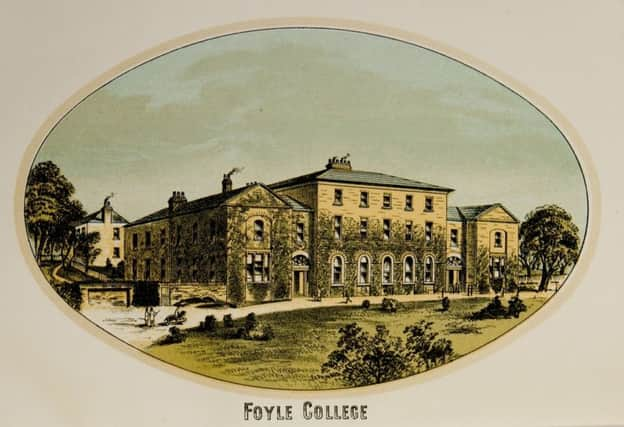War hero's photographs and historic swords mark schools' 400th anniversary


He was surgeon on the expedition in 1821 that mapped and surveyed Western Australia’s spectacularly beautiful Montgomery Reef and Islands, which were named after him by his legendary expedition-commander Philip Parker King.
One intriguing tip-off came from a Moy reader who it seems may have lived in part of the tenement building where Andrew was born and reared.
Advertisement
Hide AdAdvertisement
Hide AdAppropriately for a young man who embarked on a life of seafaring, the aforesaid tenement is only a few steps away from Lough Erne and Andrew - if this can be confirmed as his address - would therefore have been very familiar with the countless boats which plied that vast Lakeland in his day.
The research is ongoing, and more will doubtlessly be revealed here soon, about the nomadic surgeon who wrote an acclaimed medical book called ‘Some Interesting Particulars Regarding the Nature and Cure of the Cholera’. Several more celebrated globe-trotters from the past were mentioned in a recent note from Keith Beattie, the Visitor Centre and Museum Manager at Londonderry’s Siege Museum.
“A new exhibition called ‘400 Years of Foyle College’ is proving to be a very popular attraction here,” he explained.
The exhibition, opened earlier this month, contains what Keith describes as “a fascinating display of artefacts linked to the historic Londonderry school.”
Advertisement
Hide AdAdvertisement
Hide AdFoyle College can trace its origins back to 1617 when a Free Grammar School was established in Society Street, not far from Keith’s museum.
On display are some examples of the College’s old-fashioned uniforms, P.E. kits and sports jerseys, some worn as far back as the Victorian era.
There are also school trophies, rare medals, shields and other awards presented to pupils for academic and sporting achievements over the last 150 years.
“One of the most exciting exhibits is an ancient Japanese sword donated by a former pupil who served in the Far East during WWII,” Keith told me.
Advertisement
Hide AdAdvertisement
Hide AdThe fearsome-looking weapon was forged about 1,200 years ago by a famous sword-maker called Morikage whose work was known for its distinctive ‘sugata’ (configuration), ‘kitae’ (forging pattern) and ‘shirasaya’ (scabbard)…and Roamer’s spell checker has just exploded! Presented to his former school after the war by Wing Commander W.C. Pitts OBE, the curved ceremonial sword was previously owned by the ancestors of Captain Kubo of the Imperial Japanese Army, who commanded the P.O.W camp headquarters in Java.
A second sword on display in the Siege Museum is awarded to pupils who have given outstanding service to Foyle College in their final years - the General Sir George Lawrence sword.
From a venerated, well-travelled and historic family, General Sir George St Patrick Lawrence (1804-1884) was the third son of Lieutenant-Colonel Alexander Lawrence and elder brother of Sir Henry Montgomery Lawrence K.C.B., and Lord John Laird Mair Lawrence. The General’s father served and was seriously injured in India where son John later became Viceroy and Governor General and where son Henry, soldier and statesman, also served - and died in action.
According to the Dictionary of National Biography George was born in Ceylon on St Patrick’s Day in 1804, hence his middle name.
Advertisement
Hide AdAdvertisement
Hide AdEducated at Foyle College he went to Addiscombe Military Academy in Surrey in 1819 and in 1822 joined the second regiment of light cavalry in Bengal.
He took part in the Afghan War and was present at the storming of Ghuznee on 23 July 1839, a formidable fortress protected by thick, 60-feet-high walls above a flooded moat - a major problem for the British who lacked heavy artillery.
They were only able to capture it after discovering that one of the gates was poorly defended.
Under cover of darkness British military engineers piled gunpowder around the gate and blew it up.
Advertisement
Hide AdAdvertisement
Hide AdFour regiments rushed inside and bitter hand-to-hand fighting ensued.
By dawn the city was captured with a loss of 200 British men killed and wounded while the Afghans lost nearly 500 men and 1,600 were taken prisoner with an unknown number wounded.
George St Patrick Lawrence’s military and governmental postings and appointments in foreign lands brought him numerous bravery awards, military decorations and the highest of honours.
In December 1864 he ended his Indian career after a service of 43 years died in London in 1884.
Advertisement
Hide AdAdvertisement
Hide AdAfter being donated to Foyle College, the General Sir George Lawrence Sword has been the annual ‘star-pupil’ award since 1976.
It can be seen, along with all the other College artefacts, photographs and documents, in Derry’s Siege Museum.
As Foyle College merged with other schools down the years, there are other interesting artefacts on display relating to these institutions, such as an antique cow bell used in Londonderry High School to call boarding pupils to meals during the early 1900s!
The exhibition runs until September and full details are on http://thesiegemuseum.org